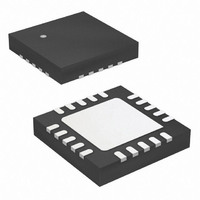ATTINY44-15MZ Atmel, ATTINY44-15MZ Datasheet - Page 158

ATTINY44-15MZ
Manufacturer Part Number
ATTINY44-15MZ
Description
MCU AVR 4K FLASH 15MHZ 20-QFN
Manufacturer
Atmel
Series
AVR® ATtinyr
Datasheet
1.ATTINY44-15MZ.pdf
(225 pages)
Specifications of ATTINY44-15MZ
Package / Case
20-QFN Exposed Pad
Voltage - Supply (vcc/vdd)
2.7 V ~ 5.5 V
Operating Temperature
-40°C ~ 125°C
Speed
16MHz
Number Of I /o
12
Eeprom Size
256 x 8
Core Processor
AVR
Program Memory Type
FLASH
Ram Size
256 x 8
Program Memory Size
4KB (4K x 8)
Data Converters
A/D 8x10b
Oscillator Type
Internal
Peripherals
Brown-out Detect/Reset, POR, PWM, WDT
Connectivity
USI
Core Size
8-Bit
Processor Series
ATTINY4x
Core
AVR8
Data Bus Width
8 bit
Data Ram Size
256 B
Interface Type
SPI, UART
Maximum Clock Frequency
16 MHz
Number Of Programmable I/os
12
Number Of Timers
2
Maximum Operating Temperature
+ 85 C
Mounting Style
SMD/SMT
3rd Party Development Tools
EWAVR, EWAVR-BL
Development Tools By Supplier
ATAVRDRAGON, ATSTK500, ATSTK600, ATAVRISP2, ATAVRONEKIT
Minimum Operating Temperature
- 40 C
On-chip Adc
10 bit, 8 Channel
Lead Free Status / RoHS Status
Lead free / RoHS Compliant
Available stocks
Company
Part Number
Manufacturer
Quantity
Price
Company:
Part Number:
ATTINY44-15MZ
Manufacturer:
ATMEL
Quantity:
1 000
Part Number:
ATTINY44-15MZ
Manufacturer:
ATMEL/爱特梅尔
Quantity:
20 000
- Current page: 158 of 225
- Download datasheet (4Mb)
20. Self-Programming the Flash
20.1
20.2
158
Performing Page Erase by SPM
Filling the Temporary Buffer (Page Loading)
Atmel ATtiny24/44/84 [Preliminary]
The device provides a self-programming mechanism (SPM) for downloading and uploading
program code by the MCU itself. The self programming can use any available data interface
and associated protocol to read code and write (program) that code into program memory.
Program memory is updated in a page-by-page fashion. Before programming a page with the
data stored in the temporary page buffer, the page must be erased. The temporary page buf-
fer is filled one word at a time using SPM, and the buffer can be filled either before the page
erase command or between a page erase and a page write operation:
Alternative 1 - Fill the buffer before a page erase
• Fill the temporary page buffer
• Perform a Page Erase
• Perform a Page Write
Alternative 2 - Fill the buffer after a page erase
• Perform a Page Erase
• Fill the temporary page buffer
• Perform a Page Write
If only a part of the page needs to be changed, the rest of the page must be stored (for exam-
ple in the temporary page buffer) before the erase, and then be re-written. When using
alternative 1, the boot loader provides an effective read-modify-write feature, which allows the
user software to first read the page and do the necessary changes, and then write back the
modified data. If alternative 2 is used, it is not possible to read the old data while loading
because the page is already erased. The temporary page buffer can be accessed in a random
sequence. It is essential that the page address used in both the page erase and page write
operation is addressing the same page.
To execute a page erase, set up the address in the Z-pointer, write "00000011" to SPMCSR,
and execute SPM within four clock cycles after writing SPMCSR. The data in R1 and R0 are
ignored. The page address must be written to PCPAGE in the Z-register. Other bits in the
Z-pointer will be ignored during this operation.
The CPU is halted during the page erase operation.
To write an instruction word, set up the address in the Z-pointer and data in R1:R0, write
“00000001” to SPMCSR and execute SPM within four clock cycles after writing SPMCSR. The
content of PCWORD in the Z-register is used to address the data in the temporary buffer. The
temporary buffer will auto-erase after a Page Write operation or by writing the CTPB bit in
SPMCSR. It is also erased after a system reset. Note that it is not possible to write more than
one time to each address without erasing the temporary buffer.
If the EEPROM is written in the middle of an SPM Page Load operation, all data loaded will be
lost.
7701E–AVR–02/11
Related parts for ATTINY44-15MZ
Image
Part Number
Description
Manufacturer
Datasheet
Request
R

Part Number:
Description:
Manufacturer:
Atmel Corporation
Datasheet:

Part Number:
Description:
Manufacturer:
Atmel Corporation
Datasheet:

Part Number:
Description:
IC MCU AVR 4K FLASH 20MHZ 20-QFN
Manufacturer:
Atmel
Datasheet:

Part Number:
Description:
IC MCU AVR 4K FLASH 20MHZ 14SOIC
Manufacturer:
Atmel
Datasheet:

Part Number:
Description:
MCU AVR 4KB FLASH 20MHZ 14SOIC
Manufacturer:
Atmel
Datasheet:

Part Number:
Description:
MCU AVR 4KB FLASH 20MHZ 20QFN
Manufacturer:
Atmel
Datasheet:

Part Number:
Description:
IC MCU AVR 4K FLASH 15MHZ 14SOIC
Manufacturer:
Atmel
Datasheet:

Part Number:
Description:
IC MCU AVR 4K FLASH 20MHZ 14-DIP
Manufacturer:
Atmel
Datasheet:

Part Number:
Description:
Manufacturer:
Atmel Corporation
Datasheet:

Part Number:
Description:
Microcontrollers (MCU) 512B FL 32B SRAM TIMER ATTINY4 12MHz
Manufacturer:
Atmel

Part Number:
Description:
IC MCU AVR 512B FLASH SOT-23-6
Manufacturer:
Atmel
Datasheet:

Part Number:
Description:
IC MCU AVR 512B FLASH SOT-23-6
Manufacturer:
Atmel
Datasheet:












